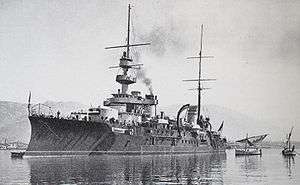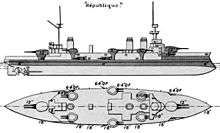République-class battleship
 Painting of Patrie | |
| Class overview | |
|---|---|
| Name: | République class |
| Operators: |
|
| Preceded by: | Charlemagne class |
| Succeeded by: | Liberté class |
| In commission: | December 1906–1928 |
| Completed: | 2 |
| Scrapped: | 2 |
| General characteristics | |
| Type: | Pre-dreadnought battleship |
| Displacement: | 14,605 t (14,374 long tons) |
| Length: | 133.81 m (439.0 ft) pp |
| Beam: | 24.26 m (79.6 ft) |
| Draft: | 8.41 m (27.6 ft) |
| Installed power: | 24 Niclausse boilers, 18,000 shp (13,400 kW) |
| Propulsion: | 3 shafts, 3 vertical triple-expansion steam engines |
| Speed: | 19 knots (35 km/h; 22 mph) |
| Complement: | 766–825 |
| Armament: |
|
| Armor: |
|
The République class was a pair of pre-dreadnought battleships of the French Navy; the ships were République, the lead ship, and Patrie. Built between 1901 and December 1906, they were actually completed at the same time as the British HMS Dreadnought, the revolutionary design of which rendered the French ships obsolete before they entered service. Nevertheless, the design for République and Patrie corrected many of the problems in earlier French battleships.
République and Patrie served in the Mediterranean Fleet for the duration of their careers, including the entirety of World War I. They saw action at the Battle of Antivari in August 1914 and spent most of 1914–15 blockading the Straits of Otranto to prevent Austro-Hungarian warships from breaking out into the Mediterranean. They both contributed some of their crews to the attempt to ensure Greek acquiescence to Allied operations in Macedonia in Athens in late 1916. They spent the rest of the war based in Athens or Salonica. After the end of the war, République was placed in reserve in 1919, disarmed in 1920 and sold for scrapping in 1921; Patrie was placed in reserve as well in 1919 and served as a training ship from 1920, until she was stricken in 1927 and she too was sold to the ship-breakers in 1928.
Design
République and Patrie were authorized in the Fleet Law of 1900, which also called for four additional battleships, which were to be the similar Liberté class.[1] The new battleship design corrected many of the defects in earlier battleships, which was accomplished through increases in the displacement and beam. They also had a significantly reduced tumblehome compared to earlier French battleships.[2]
General characteristics and machinery

The ships were 133.81 meters (439 ft 0 in) long between perpendiculars and had a beam of 24.26 m (79 ft 7 in) and a full-load draft of 8.41 m (27 ft 7 in). République displaced 14,605 metric tons (14,374 long tons; 16,099 short tons) at full load, and Patrie displaced slightly more, 14,900 metric tons (14,660 long tons; 16,420 short tons) at full load. The ships were built with a tall forecastle deck that extended all the way to the mainmast. République and Patrie retained a small fighting mast for the foremast, but had a lighter pole mast for the mainmast. They had a crew of between 766 and 825 officers and enlisted men. The ships had a metacentric height of 1.1 m (3 ft 7 in), and were equipped with bilge keels to increase their stability.[2]
The ships were powered by three 4-cylinder vertical triple expansion engines with twenty-four Niclausse boilers. The boilers were divided into three boiler rooms, each of which were trunked into their own funnel. They were rated at 18,000 indicated horsepower (13,420 kW) and provided a top speed of 19 knots (35 km/h; 22 mph). The ships were equipped with four electric generators that had a combined output of 1,000 amps at 83 volts. Coal storage amounted to 1,850 t (1,820 long tons; 2,040 short tons). At an economical cruising speed of 10 kn (19 km/h; 12 mph), the ships could steam for 8,500 nautical miles (15,700 km; 9,800 mi).[3]
Armament and armor
The main battery for the République-class ships consisted of four Canon de 305 mm Modèle 1893/96 guns mounted in two twin gun turrets, one forward and one aft. The secondary battery consisted of eighteen Canon de 164 mm Modèle 1893 guns; twelve were mounted in twin turrets, and six in casemates in the hull. She also carried twenty-five 3-pounder guns. The ship was also armed with two 450 mm (17.7 in) torpedo tubes submerged in the hull.[2]
The ships' main belt was 280 mm (11.0 in) thick at the waterline and extended for almost the complete length of the hull, from the bow to near the stern. The belt was reduced to 240 mm (9.4 in) on the top edge and 81 mm (3.2 in) on the bottom. On the bow and stern, the thicknesses were reduced to 180 mm (7.1 in), 140 mm (5.5 in), and 81 mm, respectively. The armored deck was 53 mm (2.1 in) thick amidships, and increased to 70 mm (2.8 in) on the slopes that connected to the belt. The main battery was protected by up to 350 mm (13.8 in) of armor, and had bases with 254 mm (10.0 in) thick armor plate. The secondary turrets had 150 mm (5.9 in) thick faces and 280 mm thick back plates to balance the turrets, and the casemate guns were protected with 140 mm of armor. The conning tower had 305 mm (12.0 in) thick sides.[2]
History

République was laid down in December 1901, at the Arsenal de Brest shipyard. She was launched on 4 September 1902 and after completing fitting out, was commissioned into the French Navy in December 1906. Patrie was built by the La Seyne shipyard in Toulon. She was laid down on 1 April 1902, launched 17 December 1903, and commissioned in December 1906.[2] The ships were completed at the same time as the revolutionary British battleship HMS Dreadnought; her design, which incorporated a uniform large-caliber main battery and high-speed steam turbines, rendered all other pre-dreadnoughts like the République class obsolete.[4]
République and Patrie spent their careers in the French Mediterranean Fleet, and were involved in several accidents. While Patrie was still conducting sea trials on 29 May 1907, a condenser pipe in one of her boilers burst. Several stokers were scalded, and the ship had to return to Toulon to have the condenser pipe replaced.[5] In February 1910, Patrie accidentally launched a torpedo that hit République, though the damage was not serious.[6] In Toulon in September 1911, the battleship Liberté blew up from badly decomposed propellant charges; a large piece of her armor plate struck République, which was moored nearby.[7]
Both ships were in the Second Squadron of the Mediterranean Fleet at the outbreak of World War I in August 1914.[8] They participated in the Battle of Antivari in mid-August and unsuccessfully attempted to lure out the Austro-Hungarian battle fleet.[9][10] They spent the early part of the war based at Corfu, Navarino and Malta, to keep the Austro-Hungarians bottled up in the Adriatic Sea. In 1916 the ships supported Allied operations in Salonica and also detached landing parties to support the Allied attempt to force Greek acquiescence for those operations in Athens on 1 December. They spent the rest of the war at Salonica and Athens. Patrie became flagship of the French squadron at Salonica in 1918. After the end of the war, both ships were placed in reserve in 1919.[11] République was disarmed in 1920 and stricken from the naval register in 1921 and subsequently broken up for scrap.[2] Patrie was retained longer, serving as a training ship in Toulon for mechanics and torpedomen until 1927, when she too was stricken and sold for scrap.[11]
Footnotes
- ↑ Ropp, p. 329
- 1 2 3 4 5 6 Gardiner, p. 297
- ↑ Peltier, p. 302
- ↑ Gardiner & Gray, p. 21
- ↑ "French warship damaged". The New York Times. 30 May 1907. Retrieved 13 July 2012.
- ↑ "Torpedoing report". The New York Times. 17 February 1910. Retrieved 21 July 2012.
- ↑ Alger, p. 1458
- ↑ Guernsey, p. 179
- ↑ Sondhaus, pp. 258–259
- ↑ Halpern, p. 4
- 1 2 Gille, pp. 112–13
References
- Alger, Philip R., ed. (March 1911). United States Naval Institute Proceedings. Annapolis, MD: US Naval Institute. 37. Missing or empty
|title=(help) - Gardiner, Robert, ed. (1979). Conway's All the World's Fighting Ships 1860–1905. Greenwich, UK: Conway Maritime Press. ISBN 978-0-8317-0302-8.
- Gardiner, Robert; Gray, Randal, eds. (1984). Conway's All the World's Fighting Ships: 1906–1922. Annapolis, MD: Naval Institute Press. ISBN 978-0-87021-907-8.
- Gille, Eric (1999). Cent ans de cuirassés français. Nantes: Marines. ISBN 2-909675-50-5.
- Guernsey, Irwin Scofield (1920). A Reference History of the War. New York, NY: Dodd, Mead & Co.
- Halpern, Paul G. (2004). The Battle of the Otranto Straits. Bloomington, IN: Indiana University Press. ISBN 978-0-253-34379-6.
- Jordan, John (2014). "The Battleships of the Patrie Class". In Jordan, John. Warship 2015. London: Conway. pp. 8–28. ISBN 978-1-84486-276-4.
- Peltier, J., ed. (1907). "French Battleships Republique and Patrie". International Marine Engineering. New York, NY: Marine Engineering Inc. XII: 301–303.
- Ropp, Theodore (1987). Roberts, Stephen S., ed. The Development of a Modern Navy: French Naval Policy, 1871–1904. Annapolis, MD: Naval Institute Press. ISBN 978-0-87021-141-6.
- Sondhaus, Lawrence (1994). The Naval Policy of Austria-Hungary, 1867–1918. West Lafayette, IN: Purdue University Press. ISBN 978-1-55753-034-9.
External links
![]() Media related to République class battleship at Wikimedia Commons
Media related to République class battleship at Wikimedia Commons